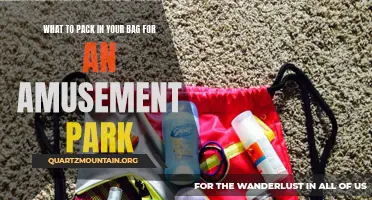
Traveling to Norway is a truly breathtaking experience, with its stunning fjords, picturesque landscapes, and vibrant cities. However, packing for this Scandinavian adventure can be a bit daunting. From the unpredictable weather to the unique cultural experiences, it's essential to be well-prepared. In this article, we will provide you with some must-know packing tips to help you make the most of your trip to Norway. So grab your suitcase and get ready to embark on an unforgettable journey through the land of the midnight sun!
| Characteristics | Values |
|---|---|
| Currency | Norwegian krone (NOK) |
| Language | Norwegian |
| Time Zone | Central European Time (CET) |
| Weather | Cold and temperate |
| Clothing | Warm, waterproof and layered clothing |
| Electrical Socket Type | Type C and F |
| Adapter | European plug adapter |
| Visa | Schengen visa (for non-EU citizens) |
| Medications | Prescription medications and basic first aid kit |
| Travel Insurance | Highly recommended |
| Transportation | Public transportation (trains, buses, ferries) and rental cars |
| Mobile Network | GSM network |
| Emergency Number | 112 |
What You'll Learn

What type of clothing should I pack for a trip to Norway?

When packing for a trip to Norway, it is important to consider the climate and the activities you plan to do. Norway has a cool and often unpredictable weather, so it is essential to pack clothing that will keep you warm and dry.
- Layering is key: The weather in Norway can vary greatly, even within a single day. It is best to pack clothing that can be layered, so you can easily adjust your outfit as the temperature changes. Start with a base layer made of moisture-wicking material, such as merino wool or synthetic fibers. This will help to keep you dry and comfortable by wicking away sweat from your body.
- Bring a warm mid-layer: After the base layer, pack a warm mid-layer such as a fleece jacket or a down vest. This will provide insulation and help to trap your body heat. Make sure to choose a mid-layer that is lightweight and easy to pack, so you can easily carry it with you when needed.
- Don't forget a waterproof outer layer: Norway is known for its rainy weather, so it is essential to bring a waterproof outer layer. Look for a jacket that is both waterproof and breathable, so you can stay dry without feeling sweaty. A hood is also important to protect your head from rain and wind.
- Pack warm accessories: In addition to your clothing layers, pack warm accessories such as gloves, a hat, and a scarf. These will help to keep your extremities warm, as they are particularly susceptible to cold temperatures. Opt for accessories made of thermal materials like wool or fleece.
- Bring sturdy and comfortable footwear: Norway is a country with beautiful landscapes and outdoor activities, so it is important to bring sturdy and comfortable footwear. Depending on your activities, consider packing a pair of hiking boots or sturdy sneakers with good traction. Make sure your footwear is waterproof or consider bringing a pair of waterproof overshoes to protect against wet conditions.
- Consider the season and location: The clothing you pack may vary depending on the season and the specific location in Norway you plan to visit. If you are traveling during the winter months or to Northern Norway, you will need additional layers and warmer clothing. If you are visiting during the summer, lighter layers and waterproof outerwear may be more suitable.
In conclusion, when packing for a trip to Norway, it is important to pack clothing that can be layered, is waterproof, and provides insulation. Bring warm accessories and sturdy footwear to stay comfortable in the changing weather. Consider the season and location to ensure you have the appropriate clothing for your trip. With the right clothing, you can enjoy your trip to Norway regardless of the weather conditions.
The Essential Items to Pack in Your Beach Bag for a Perfect Day in the Sun
You may want to see also

Are there any specific items or gear that are essential for traveling in Norway?

When planning a trip to Norway, it is important to pack the right essentials to ensure a comfortable and enjoyable experience. Norway is known for its stunning natural landscapes, but it also has varying weather conditions throughout the year. Here are some specific items and gear that are essential for traveling in Norway:
- Waterproof Jacket: Norway experiences frequent rainfall, particularly along the west coast and in the mountains. A good-quality waterproof jacket is essential to stay dry during outdoor activities such as hiking or exploring the fjords.
- Layered Clothing: Norway's weather can be quite unpredictable, and temperatures can change quickly throughout the day. It is advisable to pack layered clothing, including long-sleeved shirts, sweaters, and a warm jacket, to adjust to temperature variations.
- Hiking Boots: Norway offers incredible hiking opportunities, and having a sturdy pair of hiking boots is a must. The terrain can be rugged, with rocky trails and uneven surfaces. Investing in a good pair of waterproof and ankle-supporting hiking boots will ensure comfort and stability during hikes.
- Hat, Gloves, and Scarf: Even during the summer months, Norway can get chilly, especially in the mountains or near the coast. Packing a hat, gloves, and a scarf will help keep you warm, particularly during early mornings or late evenings.
- Sunscreen and Sunglasses: Despite Norway's northern latitude, the sun can still be strong, especially during the summer months. Remember to pack sunscreen with a high SPF to protect your skin from harmful UV rays. Sunglasses are also essential to shield your eyes from the glare reflected off the snow or water.
- Backpack: A sturdy backpack is essential for day trips or longer hikes. It should have enough capacity to carry essentials such as water, snacks, a map, compass, and extra layers. Look for a backpack with padded straps for added comfort while hiking.
- Travel Adapter: Norway uses a different type of power outlet (Type C and F) than many other countries. As such, a travel adapter is necessary to plug in your electronic devices and charge them during your stay.
- Cash and Credit Cards: Although Norway is mostly a cashless society, it is always a good idea to have some local currency for smaller establishments or emergencies. Credit cards are widely accepted, but note that some remote areas or smaller towns might have limited card payment options.
- First Aid Kit: It is important to have a basic first aid kit with you when traveling in Norway. This should include adhesive bandages, antiseptic ointment, painkillers, and any necessary prescription medications. If you plan to engage in outdoor activities, consider including supplies such as blister pads, insect repellent, and a whistle for emergencies.
- Travel Insurance: Lastly, but certainly not least, travel insurance is essential when visiting Norway. It provides coverage for medical emergencies, trip cancellations, lost luggage, and a range of other unexpected situations. Ensure that your insurance covers outdoor activities such as hiking, skiing, or fishing if you plan to partake in these activities.
By packing these essential items and gear, you will be well-prepared to enjoy your trip to Norway and make the most of its natural beauty and outdoor adventures. Remember to check the specific weather conditions for the time of year you'll be visiting and adjust your packing list accordingly. Safe travels!
The Essential Food Packing Guide for Your Next Camping Trip
You may want to see also

What is the weather like in Norway, and how should I dress accordingly?

Norway is known for its breathtaking landscapes, fjords, and northern lights, but it is also notorious for its unpredictable and harsh weather conditions. If you are planning to visit this beautiful country, it is essential to know what the weather is like and how to dress accordingly. In this article, we will explore the different regions of Norway and provide you with practical advice on dressing for the weather.
Norway experiences a varied climate due to its elongated shape and numerous fjords. The western coast, including cities like Bergen and Stavanger, is known for its mild and wet climate. It often rains throughout the year, so it is crucial to bring a waterproof jacket or coat. Layering is key in these regions, as the weather can change quickly. Start with a base layer made of thermal or moisture-wicking material, add a light sweater or fleece, and top it off with a waterproof outer layer. Don't forget to bring a solid pair of waterproof shoes or boots to keep your feet dry during your outdoor adventures.
Inland areas, such as Oslo and Lillehammer, have a more continental climate with distinct seasons. Summers can be warm and pleasant, with temperatures reaching the mid-20s Celsius (mid-70s Fahrenheit). Light clothing, including shorts and T-shirts, are suitable for this time of the year. However, it is also wise to bring a light jacket or sweater for chilly evenings. Winters in these areas can be bitterly cold, with temperatures dropping below freezing. Layering is essential during this season. Start with a thermal base layer, add a thick sweater or fleece, and finish with a windproof or insulated jacket. Don't forget to protect your extremities by wearing gloves, a hat, and thick socks.
In the northernmost parts of Norway, such as Tromsø and Kirkenes, the climate is subarctic, and extreme weather conditions are common. Summers are short, with temperatures rarely exceeding 15 degrees Celsius (60 degrees Fahrenheit). Thermal base layers, long-sleeved shirts, and lightweight jackets are recommended during this time. Winters in the Arctic regions can be brutally cold, with temperatures dropping well below freezing. Dressing for this climate requires special attention. Start with a thermal base layer, add multiple layers of insulating clothing like down or fleece, and finish with a windproof and waterproof outer layer. Mittens or gloves, a warm hat, and thermal socks are essential to protect yourself from frostbite.
It is important to note that regardless of the season or region in Norway, it is always wise to pack a sturdy pair of waterproof shoes or boots. The weather can change rapidly, and staying dry is crucial to staying comfortable and safe during your time outdoors.
In conclusion, Norway's weather can be quite unpredictable, and it varies significantly depending on the region and season. From mild and wet on the western coast to cold and snowy in the northern Arctic regions, it is essential to dress in layers and pack appropriately for your visit. Remember to bring waterproof clothing, thermal base layers, insulating layers, and protective gear for your extremities. By being prepared, you can fully enjoy the stunning landscapes and natural wonders that Norway has to offer, regardless of the weather.
Must-Have Packing List for Allegheny College Students
You may want to see also

Are there any cultural considerations or dress codes to be aware of in Norway?

Norway, a country known for its stunning natural landscapes and vibrant cities, is a popular destination for tourists from all over the world. If you're planning a trip to Norway, it's important to be aware of the cultural considerations and dress codes that are unique to this country.
One key aspect to keep in mind is the Norwegian concept of "janteloven." Janteloven is a cultural norm in Norway that emphasizes humility and modesty. It discourages individuals from boasting about their achievements or flaunting their wealth. Visitors to Norway should respect this cultural value and avoid overt displays of wealth or status.
In terms of dress codes, Norwegians tend to have a casual and practical approach to fashion. It is generally acceptable to dress informally in most situations, even for formal occasions. However, it is still important to dress appropriately for the weather conditions, especially if you are planning outdoor activities. Norway's climate can be quite unpredictable, so it's a good idea to bring layers and waterproof clothing.
When visiting religious sites, such as churches or mosques, it is respectful to dress modestly. Women may be expected to cover their shoulders and knees, and both men and women should remove their hats. It's also a good idea to avoid wearing overly revealing or provocative clothing in public spaces, as it may be seen as disrespectful.
In some traditional or formal settings, such as dining at a high-end restaurant or attending a business meeting, it is customary to dress more formally. Men may be expected to wear a suit and tie, while women may opt for a dress or a blouse with trousers or a skirt.
Another important cultural consideration in Norway is punctuality. Norwegians value time and expect others to be on time for appointments or social gatherings. Arriving a few minutes early is considered polite, while being late without a valid reason is seen as disrespectful. It's always a good idea to plan your schedule accordingly and allow for extra time to account for transportation delays or unforeseen circumstances.
In conclusion, when visiting Norway, it is important to be aware of the cultural considerations and dress codes that are unique to the country. Understanding the concept of janteloven, dressing appropriately for the weather and the occasion, respecting religious sites, and valuing punctuality will ensure a respectful and enjoyable experience in Norway.
Essential Packing Tips for Tauck River Cruises
You may want to see also

Are ther

Multivitamins have become popular in recent years as a way to supplement the nutrients that may be lacking in our daily diet. These pills contain a combination of various vitamins and minerals that are essential for our overall health and well-being. However, like any other medication or supplement, multivitamins may also have some side effects on our body.
Firstly, it is important to note that multivitamins are considered safe for most people when taken in recommended dosages. However, some individuals may experience digestive issues such as nausea, constipation, or stomach discomfort when taking these supplements. This is especially true for those who take high-dose multivitamins or have pre-existing gastrointestinal conditions.
In some cases, certain vitamins and minerals in multivitamins may interact with certain medications, leading to adverse effects. For example, high doses of vitamin E can interfere with blood clotting medications, while vitamin K can interfere with blood thinners. It is always advisable to consult with a healthcare professional before starting any new supplements, especially if you are on medication.
Moreover, some people may be allergic to certain ingredients present in multivitamins. This can result in allergic reactions such as itching, hives, or even more severe symptoms like difficulty in breathing. It is essential to read the label carefully and check for any allergens before consuming multivitamins.
Additionally, excessive intake of certain vitamins and minerals can result in toxicity. Fat-soluble vitamins, such as vitamins A, D, E, and K, are stored in the body and can accumulate to harmful levels if taken in excess. This can lead to symptoms like dizziness, nausea, and even organ damage. It is crucial to follow the recommended dosage guidelines and not exceed the daily limits for each nutrient.
It is worth mentioning that the side effects of multivitamins are rare and usually occur when taken in excessive amounts or by individuals with underlying medical conditions. For most people, consuming a balanced diet that includes a variety of nutrient-rich foods can provide all the necessary vitamins and minerals without the need for supplements.
In conclusion, while multivitamins are generally safe for consumption, they may have side effects in some individuals. These can include digestive issues, interactions with medications, allergic reactions, and toxicity if taken in excessive amounts. It is important to consult with a healthcare professional and adhere to the recommended dosage guidelines to minimize any potential risks. Ultimately, a well-balanced diet should be the primary source of essential nutrients, and supplements should only be taken when necessary and under professional guidance.
The Essential Packing Guide for Your Trip to LEGOLAND Florida
You may want to see also
Frequently asked questions
When packing for a trip to Norway, it is important to consider the climate and weather conditions. Norway has a varied climate, so it is best to pack layers of clothing that you can easily add or remove as needed. It is also a good idea to pack a waterproof jacket or raincoat, as Norway experiences frequent rainfall. Additionally, don't forget to pack sturdy walking shoes or boots, as there may be opportunities for outdoor activities and hiking. Finally, don't forget to bring adapters for your electronics, as Norway has a different electrical outlet style than some countries.
If you plan on participating in outdoor activities in Norway, it is a good idea to pack appropriate gear. For example, if you plan on skiing or snowboarding, make sure to bring warm, waterproof clothing, including thermal underwear, jackets, and pants. Additionally, you may want to pack goggles, gloves, and a hat to protect yourself from the cold. If you plan on hiking, a good pair of hiking boots, a backpack, and a map or GPS device can be helpful. Remember to always check the weather conditions and pack accordingly.
While visiting cities in Norway, you can dress more casually and comfortably. It is a good idea to pack comfortable walking shoes or sneakers, as you may be doing a lot of sightseeing on foot. Bring a light jacket or sweater for cooler evenings, as well as a raincoat or umbrella for any unexpected rain showers. Norway has a vibrant and cosmopolitan culture, so you may also want to pack some nicer clothes for evenings out or dining at upscale restaurants.
If you are visiting Norway with the hopes of seeing the Northern Lights, there are a few items you may want to pack. Firstly, make sure to bring a good camera with manual settings, as capturing the Northern Lights can be challenging. Additionally, pack extra batteries and memory cards for your camera, as the cold weather can drain battery life quickly. You may also want to pack a tripod to stabilize your camera for long exposure shots. Lastly, don't forget to bring warm clothing, including hats and gloves, as you may be spending extended periods of time outside while waiting for the lights to appear.
When preparing for a trip to Norway, it is always a good idea to pack some basic safety items. This includes a basic first aid kit with band-aids, pain relievers, and any necessary prescription medications. It is also a good idea to pack a travel lock for your luggage and a money belt to keep your valuables safe. Additionally, make sure to have a photocopy of your passport and important travel documents in case of loss or theft. Finally, bring a portable charger or extra batteries for your electronics to ensure you can stay connected during your trip.







